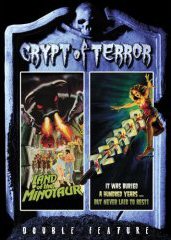
The possibility of the contemporary survival of ancient Mother Goddess and fertility cults has long been an invigorating theme for fantastic literature and film. An idea that appeals to the animalistic desire and imaginative wellspring in us even as it awakens ancient cross-cultural fears, the idea of sacrifice to ancient pagan deities has played an important role in films since the genre's conception, evoking dark echoes of the panic originally thought inspired by encounters between human beings and the supernatural forces of glen or spring. Most effective are those movies that depict the occult not so much as completely separate from our world so much as hidden but very real components of existence. In such films, reality is revealed to be little more than a flimsy notion, an illusion, within which nightmarish forces of upheaval lurk. The third instalment of BCI's CRYPT OF TERROR, featuring Land of the Minotaur (1977) and Terror (1979), offer viewers the chance to revisit (or perhaps enjoy for the first time) an eclectic pairing of two flawed yet intriguing celebrations of terror and mystery. While far from great art, both are solid genre efforts, managing to entertain despite low budgets, and well worth your time for their essential strangeness and inherent shlock appeal.
Genre veterans Peter Cushing and Donald Pleasance -- both of which brought a level of true professionalism and belief to practically every one of their respective performances -- star in Land of the Minotaur, an uneven if atmospheric occult thriller than attempts to evoke the essential mystery of pre-Christian worship. When an American priest travels to Greece, he finds a malignant cult that worships strange gods and makes human sacrifices. Soon it falls to him to struggle against his own fear and the supernatural in attempts to save innocent souls in threat of perdition. Greek director Costa Carayiannis's devilish stew of Satanic rites, pagan mysteries, and the nature of sacrifice is effective despite itself, inviting laughs alongside a few minor chills. Embedded in supernatural folklore, merging suspense with a somber and somewhat strained atmosphere, this is a surprisingly mature example of 'quiet' terror. Cushing as Baron Corofax is evil personified, and while it hardly ranks as his best performance, the aged thespian injects his broad role of evil with cold grace and charm. His leering persona is a fitting contradiction when compared with Pleasance's hyper man of faith. Crucial to the plot (and the film's overall mood) are the ancient rites that pepper the story with needed atmosphere, and which would be more effective if not for the ridiculous looking minotaur statue! "The old customs remain and the ancient gods live on!" proclaims Cushing, and as Pleasance's holy man -- a representative of the new religion -- attempts to fathom the timeless mysteries, we are reminded of a forgotten world.
The second feature, Terror (1979), documents the cursed attempts of a filmmaker to fathom the ancestral curse which he wakens when he shoots a film about his own family's dark history. In the dreary, realistically captured 16th Century, a witch is burned by Ye Olde Squire, vowing to return and wreak vengeance on her oppressor's descendents. Some three hundred years later, her spirit is allowed the opportunity to do just that as a film director James Garrick, a descendent of the Squire, makes a movie about that very tragedy. As art begins to imitate life and vice versa, people begin dying in spectacularly gruesome ways. Not long after, Garrick is forced to wonder if the witch's spirit isn't very much alive, and as hateful as legend claims. As people connected with his doom-haunted film continue to die, the fragile line between the supernatural and normalcy, guilt and innocence erodes.
Exploring the supernatural and its relation to the fragile, materialistic mind of man from a different philosophical and intellectual vantage point, this wholly British production captures the decrepit dark beauty of a grand gothic. Norman J. Warren, an inventive and enthusiastic grade-B filmmaker, injects his spectral tragedy with lyricism and true exploitative verve. His characters are believable if a bit transparent, and the shocks, when they come, are spectacularly gruesome. More impressive is the constant mood of a surreal nightmare that practically drips from the sets and countryside. Shadows lurk, swirls dance like lost souls, and character's inner doubts and fragile relationships mirror the occult terrors. Including believable performances and surprisingly graphic set-pieces, this oft maligned film, written by David McGillivray, is at once a celebration and refutation of Britain's horrific past. In his experimental narrative framework (depicting the 'reality' of the film-within-a film), and, more importantly, his insertion of black comedy, Warren creates a refutation of reality and a bid for a new style. While bloody murders are the order of the day, an elegant moodiness is also maintained, both in the sentient settings of and gritty sprawl of modernity.
This Crypt of Terror package presents these small budget affairs with impressive if not brilliant clarity. While both prints are considerably cleaner than previously, occasional flaws persist. Land of the Minotaur is presented in 1.85:1 widescreen, and has never looked better. Gone is much of the speckling, blotching, and bothersome lines that plagued the VHS prints. Colors are bright and vivid, mirroring with deep, somber hues the darkly fantastic premise. Terror is even more of a visual treat, the transfer vividly sharp. Detail is wonderful, with very little evidence of scratching or grain. Both films feature Dolby Digital 2.0. Minor hissing occurs in the beginning track for Minotaur but the remainder is sharp and effective, especially considering the suspected condition of original materials. While no extras are included, these two neglected occult thrillers belong on the shelves of adventurous film fans.
Review by William P. Simmons
| Released by Brentwood |
| Region 1 - NTSC |
| Not Rated |
| Extras : |
| see main review |